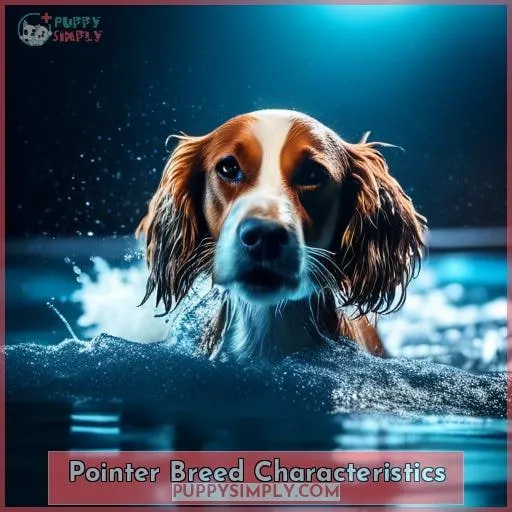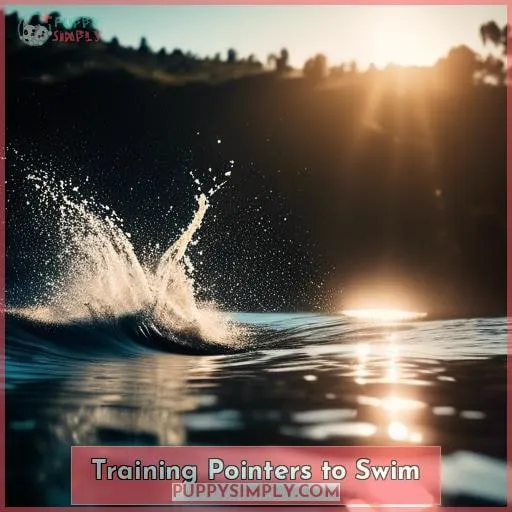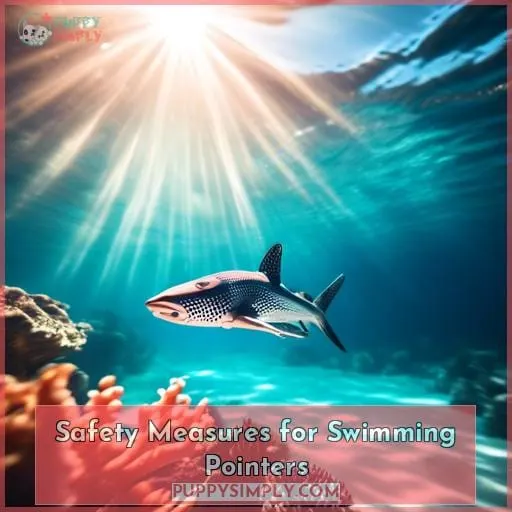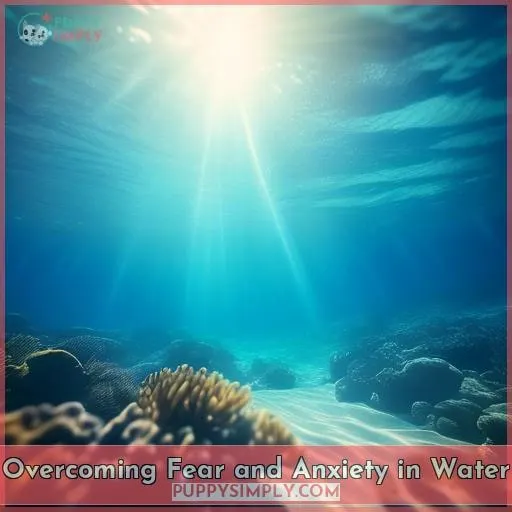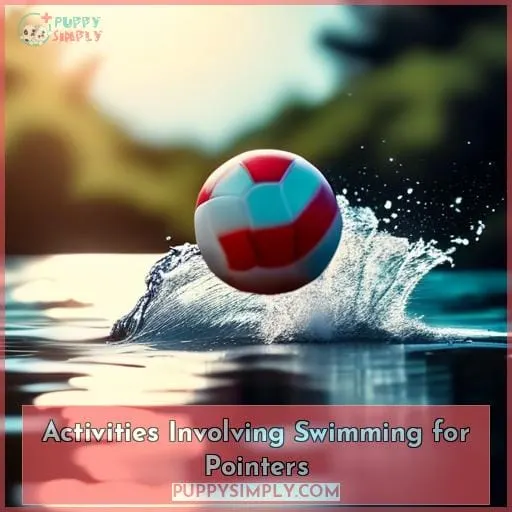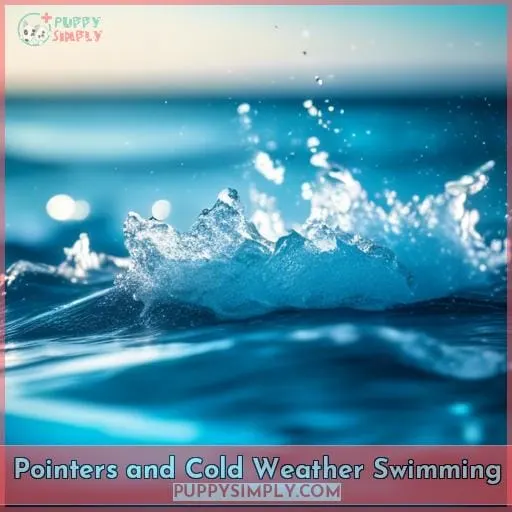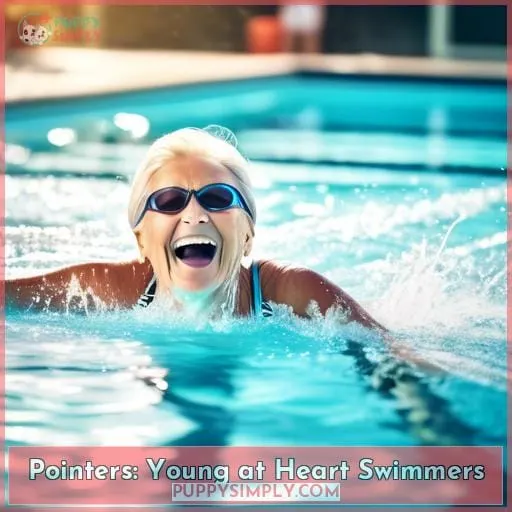This site is supported by our readers. We may earn a commission, at no cost to you, if you purchase through links.
 Pointers, with their athletic build and boundless energy, are more than capable of swimming.
Pointers, with their athletic build and boundless energy, are more than capable of swimming.
While not all Pointers naturally take to water, with patience and the right approach, you can tap into their potential for aquatic adventures.
Whether you’re aiming to enhance their hunting skills or simply enjoy a splash together, understanding and nurturing your Pointer’s swimming abilities can lead to a fulfilling and safe experience for both of you.
Let’s dive into the essentials of helping your water-loving dog navigate the waves with confidence.
Table Of Contents
- Key Takeaways
- Understanding Pointer Breeds
- Pointer Breed Characteristics
- Pointers and Their Hunting Abilities
- Pointers and Water: Natural Affinity or Not?
- Training Pointers to Swim
- Safety Measures for Swimming Pointers
- Overcoming Fear and Anxiety in Water
- Activities Involving Swimming for Pointers
- Pointers and Cold Weather Swimming
- Pointers: Young at Heart Swimmers
- Frequently Asked Questions (FAQs)
- How do German Shorthaired Pointers react to cold water temperatures, and what precautions should be taken?
- Can Pointers participate in water-based dog sports, and if so, which ones are most suitable?
- What are the grooming needs of a Pointer after swimming to maintain coat and skin health?
- How does the Pointer’s hunting instinct influence their behavior in water, especially in natural settings?
- What are the health considerations to keep in mind for Pointers who frequently swim, particularly regarding ear care?
- Conclusion
Key Takeaways
- Pointers, while not known for their swimming abilities, do have the physical capability to swim. Their athletic and strong build allows them to swim for both fun and work, but individual personalities and experiences can influence their willingness to enter the water.
- German Shorthaired Pointers, a specific breed of Pointers, are known to be excellent swimmers. They are naturally strong, athletic, and have webbed feet, which aids in their swimming abilities.
- Training Pointers to swim requires patience, understanding, and positive reinforcement. It’s recommended to start in shallow water and gradually increase the depth as the dog becomes more comfortable. The use of a buddy system with confident swimmers can also be beneficial.
- Safety measures are crucial when Pointers are swimming. Close supervision, the use of a life jacket, and choosing safe swimming locations are all important. It’s also necessary to check the water temperature and conditions to ensure the dog’s safety.
Understanding Pointer Breeds
Pointers, including the German Shorthaired Pointer (GSP) and the English Pointer, have a rich history as hunting dogs, with their origins tracing back to the 1800s in Germany and England, respectively.
While both breeds are known for their athleticism and hunting skills, their abilities in water can differ.
GSPs are generally good swimmers, often equipped with webbed feet, and enjoy water activities.
English Pointers may not be natural swimmers and don’t typically have webbed feet.
However, with encouragement and training, many English Pointers can learn to swim and may come to enjoy it.
It’s important to note that each dog is an individual, and their affinity for water can vary.
History and Origins of Pointers
Pointers have a storied past, with roots stretching back to the Middle Ages in countries like Italy, France, and Spain.
Origin Insights and Breeding History:
- Pointers have ancestral roots in Europe, with the earliest mentions dating back to the 18th century in England.
- The development timeline of Pointers in America began around 1850, with the breed evolving significantly over the years.
- The German Shorthaired Pointer (GSP), a variant of the breed, was developed in Germany in the late 1800s as an all-around hunting dog.
- Heritage exploration reveals that Pointers were bred for their hunting abilities, including pointing and retrieving game, and their high energy levels requiring ample exercise.
German Shorthaired Pointers Vs. English Pointers
When comparing the German Shorthaired Pointer’s and English Pointer’s breeds, it’s essential to recognize each breed’s unique characteristics and preferences.
While both are esteemed for their hunting abilities, they exhibit distinct physical characteristics, temperament traits, and training techniques.
German Shorthaired Pointers are known for their versatility in water adaptation, making them more inclined to enjoy swimming activities.
On the other hand, English Pointers aren’t natural swimmers, though some may learn to enjoy water with proper encouragement and safety measures.
Here’s a quick comparison to help you understand the differences:
| Aspect | German Shorthaired Pointer | English Pointer |
|---|---|---|
| Size | Medium to large | Medium to large |
| Coat | Short, dense | Short |
| Temperament | Energetic, trainable | Gentle, independent |
| Water Adaptation | Webbed feet, better swimmers | Not natural swimmers |
| Training Techniques | Highly trainable | May be stubborn |
Understanding these differences can help you provide the best care and training for your pointer, ensuring they lead a happy, healthy life whether on land or in water.
Pointer Breed Characteristics
You know your energetic Pointer loves nothing more than a good swim.
While it’s great they enjoy water activities, be mindful of keeping up with their grooming needs and providing the exercise they crave to stay healthy and happy.
Make sure to supervise their swimming since their high energy could lead them to overexertion if left unchecked.
Temperament and Energy Levels
Pointers’ energetic temperaments and high activity levels are breed characteristics.
A buddy system with another dog owner can be an effective socialization technique to help an inexperienced pointer stay active and engaged.
Training methods should include at least two vigorous exercise sessions per day, with swimming, running, or organized dog sports as ideal outlets.
Make any needed behavioral adjustments through positive reinforcement training tailored to the individual puppy rather than punishment.
Adjust environmental factors by providing enough stimulation and activity.
Understand canine psychology around high prey drive in sporting dogs.
Health and Grooming Needs
Regarding your Pointer’s health and grooming needs:
- You’d be dealing with a good amount of shedding and should be on the lookout for common hereditary health issues.
- Brush its double coat regularly with a grooming glove or rubber brush to remove loose hair and prevent mats.
- Trim nails regularly to prevent discomfort.
- Provide a healthy diet and regular vet checkups to ensure overall health and well-being.
- Grooming a few times a week will manage shedding while keeping its coat in good shape for dog sports.
Pointers and Their Hunting Abilities
Pointers are versatile hunting dogs, capable of pointing, retrieving, and even swimming after fallen birds.
Their natural ability to point makes them excellent hunting companions when going after various game birds and waterfowl.
While not all pointers take readily to water, many can be encouraged to swim and retrieve with proper training and technique.
Versatility in Hunting
While pointers are renowned for their exceptional field skills, it’s your involvement in their training that unlocks their full potential as versatile hunters, capable of pointing and retrieving both on land and in water.
Breeds comparison reveals that consistent training techniques are crucial.
Safety precautions and understanding psychological factors enhance their hunting prowess.
Proper physical conditioning ensures they excel in various terrains and situations.
Pointing and Retrieving Skills
Pointers possess an innate ability to both point out game and retrieve it, making them invaluable companions on your hunting expeditions.
To enhance their natural talents, follow these steps:
-
Focus on improving technique through consistent practice.
-
Invest in advanced training sessions for precision.
-
Explore performance enhancement by simulating real hunting scenarios.
-
Engage in skill refinement to develop competitive strategies for field trials.
Pointers and Water: Natural Affinity or Not?
Can pointers swim?
The answer isn’t as straightforward as you might think.
While pointers aren’t natural swimmers, some can learn to enjoy the water.
Others may even become strong swimmers with proper training and encouragement.
Swimming Abilities of Pointers
Your German Shorthaired Pointer’s affinity for water and strong swimming abilities stem from their hunting heritage, making them excellent companions for aquatic adventures.
However, not all Pointers are born with aquatic instincts or swim readiness. Some may exhibit hydrophobic tendencies.
With patience and positive reinforcement, you can boost their water confidence and paddling proficiency, turning any initial apprehension into a love for swimming.
Factors Influencing a Pointer’s Affinity for Water
When it comes to your pointer’s affinity for water, both breed-specific traits and individual personality play crucial roles.
Breed Characteristics:
- Some pointers are naturally more inclined towards water activities.
Past Experiences:
- Early and positive exposure to water can significantly influence their comfort and enjoyment.
Personality:
- Each dog’s unique temperament affects their willingness to engage with water.
Training Pointers to Swim
When it comes to training your Pointer to swim, it’s essential to approach the process with patience and understanding.
Not all Pointers are natural swimmers, so introducing them to water gradually and making the experience positive is key.
By using techniques like positive reinforcement and starting in shallow water, you can help your Pointer become comfortable and even enjoy swimming.
Introducing Pointers to Water
Acclimatization is key when teaching your dog to swim. It helps build their confidence and ensures a positive experience with water.
Start with gradual exposure, letting your Pointer explore shallow areas first.
Employ positive reinforcement, rewarding each small step with treats or praise.
Water play should be fun, so consider the buddy system, pairing your pup with a confident swimmer to boost their courage.
Encouraging Swimming in Pointers
Building on your pointer’s natural affinity for water, you can enhance their swimming skills through positive reinforcement and gradual exposure.
Encourage confidence by introducing water games and using a buddy system with other dogs.
Always remember safety precautions to ensure a positive and secure environment.
With patience and consistency, your pointer will soon be splashing around with joy and confidence.
Safety Measures for Swimming Pointers
When introducing your Pointer to swimming, it’s crucial to prioritize their safety.
Always supervise them closely in the water, as Pointers aren’t natural swimmers and each dog will have its own comfort level with water.
For added security, consider outfitting your dog with a life jacket, especially if they’re new to swimming or if you’re in open water where conditions can change rapidly.
Supervision and Precautions
Ensuring your pointer’s safety during swimming sessions requires vigilant supervision and appropriate precautions.
- Prioritize water safety by teaching swim readiness skills.
- Always have a canine lifeguard on duty for supervised fun.
- Use precautionary measures like fitting your dog with a life jacket.
- Choose safe swimming locations, free from hazards.
- Regularly check water temperature and conditions before letting your dog swim.
Use of Life Jackets and Other Safety Gear
While keeping a close eye on your Pointer during swimming sessions is crucial, equipping them with the right safety gear, such as a well-fitted life jacket, can provide an extra layer of protection and peace of mind.
Overcoming Fear and Anxiety in Water
If your Pointer shows fear or anxiety around water, it’s crucial to address these feelings gently and patiently.
Techniques like desensitization and counterconditioning can help your dog become more comfortable and even enjoy swimming.
By identifying the root of their fear and gradually introducing them to water in a positive way, you can turn apprehensive paddles into confident swims.
Identifying and Addressing Fear or Anxiety
When tackling your dog’s fear of water, it’s crucial to:
- Zero in on what’s causing their anxiety and gently guide them past it.
- Identify fear triggers and anxiety sources as the first step.
Employ desensitization techniques and counterconditioning methods to build confidence.
If progress stalls, don’t hesitate to seek professional guidance to ensure a positive and safe swimming experience for your pointer.
Techniques for Desensitization and Counterconditioning
You’ll want to ease into water exposure by:
- Starting with just having your pointer look at or be near water.
- Pairing that with treats and praise so they associate good feelings with it.
Use desensitization and counterconditioning techniques like:
- Gradually increasing water exposure.
- Ensuring a positive experience with treats and praise.
To help your pointer overcome any fear or anxiety related to the water.
Implement these anxiety management methods consistently to transform the water into something your pointer feels comfortable with.
Activities Involving Swimming for Pointers
Here are some ideas for water-based activities and games you can enjoy with your pointer if they like swimming:
Consider entering dock diving or field trials tests, which allow them to fully utilize their athletic swimming abilities.
The exercise is also great mental stimulation.
Or simply play fetch, using water retrieves to satisfy their prey drive in a safe, controlled way.
Water Sports and Games for Pointers
You can engage your pointer in various water sports and games once they’re comfortable swimming.
These activities provide fun ways to exercise and bond with your water-loving dog:
- Try water fetch with floating toys.
- Let your pointer leap off docks into the water.
- Go on stream adventures together.
- Host splash sessions with the hose in the summer.
- Visit pools where your dog can retrieve items and play.
Varying water games will delight your energetic pointer.
Benefits of Swimming for Pointers
Through swimming, you’re providing your pointer with a low-impact, total body workout that strengthens muscles, increases range of motion in joints, and improves cardiovascular health in a fun way it’ll love.
Swimming offers pointers physical and mental stimulation in a safe, controlled environment; plus, it builds the bond between you and your canine companion.
Pointers and Cold Weather Swimming
When the weather turns cold, your water-loving pointer may still want to take a dip.
Use caution if you allow swimming in frigid temperatures, as this can pose safety risks.
Take appropriate precautions to keep your pointer comfortable and safe if they’re determined to continue swimming in cold conditions.
Challenges of Swimming in Cold Weather
With cold weather swimming presenting unique dangers, you’ll want to take several precautions before letting your pointer take a dip during frigid months.
Chilling challenges include hypothermia and icy surfaces.
Winter swimming tips include using protective gear like a doggy wetsuit and monitoring your pet closely.
Precautions for Cold Weather Swimming
While pointers may enjoy water activities, it’s crucial to take certain precautions when swimming in cold weather to ensure their safety and well-being.
Always monitor their body temperature and look for signs of hypothermia.
Use winter swimming tips like providing a warm towel post-swim.
Follow icy conditions guidelines, avoiding frosty dips when temperatures plummet.
Pointers: Young at Heart Swimmers
Pointers, known for their energy and agility, often maintain their love for swimming well into their senior years.
Regular swimming can be a fantastic way for your Pointer to stay fit and healthy, offering a low-impact exercise that’s gentle on their joints.
So, whether your Pointer is a young pup or a seasoned swimmer, encouraging regular dips can contribute to their overall health and happiness.
Maintaining Swimming Abilities Into Old Age
Although pointers can face challenges when swimming in cold weather, maintaining their swimming abilities into old age is crucial.
You’ll find they’re often just as eager to jump into the water later in life as they were in their youth.
Geriatric Aquatics: Keep them active with gentle water exercises.
Retaining Swim Agility: Regular swimming helps maintain muscle tone.
Paddling Pensioners: Encourage them, but respect their pace and comfort.
Encouraging Regular Swimming for Health and Happiness
To maintain their health and happiness, pointers, young at heart swimmers, should be encouraged to engage in regular swimming sessions.
Building confidence in the water is key, especially for fearful pups.
Incorporate water games for fun and always put safety first.
Keep it positive and your pointer will be splashing happily in no time!
Frequently Asked Questions (FAQs)
How do German Shorthaired Pointers react to cold water temperatures, and what precautions should be taken?
German Shorthaired Pointers can become uncomfortable in very low temperatures, and prolonged exposure may lead to hypothermia.
They’re not built for frigid waters like longer-haired breeds, but with proper gear like neoprene vests, and precautions such as heaters and towels for warmth, they can manage short periods in cold water.
Always monitor their condition closely, limit their time in cold water, and ensure they’re dry and warm afterward to prevent health issues.
Can Pointers participate in water-based dog sports, and if so, which ones are most suitable?
Indeed, Pointers, particularly German Shorthaired Pointers, can participate in water-based dog sports.
They excel in dock diving, a sport where dogs compete in jumping for distance or height from a dock into water.
Their natural agility, energy, and love for water make them suitable for such activities.
What are the grooming needs of a Pointer after swimming to maintain coat and skin health?
After swimming, rinse your Pointer’s coat with fresh water to remove chlorine or salt.
Towel-dry, then brush to prevent mats and keep the coat glossy.
Check and clean their ears to avoid infections.
How does the Pointer’s hunting instinct influence their behavior in water, especially in natural settings?
Like a seasoned archer with an arrow poised, your Pointer’s hunting instincts draw it to the water.
Where its innate skills shine, in natural settings, the sight or scent of potential prey can transform a calm swim into a focused hunt.
What are the health considerations to keep in mind for Pointers who frequently swim, particularly regarding ear care?
Regularly clean and dry your Pointer’s ears after swimming.
This will help prevent infections like swimmer’s ear.
Consult a vet for any signs of irritation.
Conclusion
Ready to see your Pointer thrive in the water?
With their innate athleticism and versatile hunting skills, Pointers can swim and even excel in aquatic environments.
By understanding their breed characteristics, gradually introducing them to water, and ensuring their safety with the right gear, you’ll unlock a world of joy and health benefits for your furry friend.
Embrace the splashes and cherish the moments as your Pointer paddles towards a happy, heart-healthy lifestyle.


